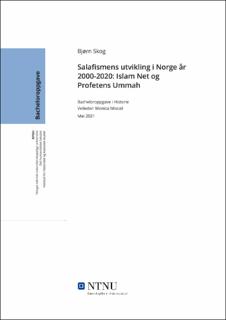| dc.contributor.advisor | Miscali, Monica | |
| dc.contributor.author | Skog, Bjørn | |
| dc.date.accessioned | 2021-09-13T16:08:39Z | |
| dc.date.available | 2021-09-13T16:08:39Z | |
| dc.date.issued | 2021 | |
| dc.identifier | no.ntnu:inspera:80115080:50647748 | |
| dc.identifier.uri | https://hdl.handle.net/11250/2775738 | |
| dc.description.abstract | Dette studiet tar utgangspunkt i salafismens opprinnelse og utvikling i Norge. I sentrum av ideologien er de to norske organisasjonene Islam Net og Profetens Ummah, som begge praktiserer et salafistisk tankemønster. Vi skal se nærmere på organisasjonenes utvikling i forhold til hvilke salafistiske tolkninger de følger, deres frontfigurer, medlemstall, og retoriske tilnærming. Metoden for studiet er primært gjennom kvantitative analyser, nasjonale aviser, og i tillegg trekke inn tidligere forskning. Studiet vil strekke seg fra år 2000 til 2020 for å gi et klarere bilde av utviklingen, men vil primært oppholde seg fra 2008, hvor salafismen blir offentlig via Islam Net, frem til 2020. I tillegg til å få en forståelse for hva salafisme er, hvordan det har utviklet seg, og hvem som har utviklet det, skal bevegelsen av motstandsgrupper av islam (og derav salafisme) analyseres under samme periode. Dette for å se om det kan være en korrelasjon mellom salafismens synlige negative medieomtale, kan ha ført til islamofobisk tankesett i slike bevegelser. Det vil ses nærmere på ytterligere primærkilder og organisasjonenes hjemmesider og Facebook-grupper til nevnte miljøer. Vi vil også se på om salafismen og dens relativt høye mediedekning, til dels gjennom IS i nevnte periode (som kan knyttes til en salafistisk ideologi), kan ha påvirket norske muslimer og hvordan de ble sett på av samfunnet. Mot slutten av studiet ser vi på hvilken posisjon salafisme har i samfunnet. Her vil det vises til resultat fra analyse, diskuteres og avrundes med en oppsummering. | |
| dc.description.abstract | This study is based on Salafism’s founding and development in Norway. In the ideology’s centre is the two Norwegian organisations Islam Net and Profetens Ummah, who both follow a Salafistic mindset. We will take a closer look on the organization’s development in terms of their Salafistic interpretation, leading figures within the organisations, how many followers they have, and their rhetoric approach. The method of this study is primarily through quantitative analysis, national papers, and by involving earlier research. This study is between year 2000-2020 to give a clearer view of the development but will mostly focus around 2008, where Salafism for the first time reaches the public sphere thru Islam Net, and extends to 2020. By giving the reader an understanding of what Salafism is, how it has developed, and who has developed it, we will also analyse the opposition of Islam (and by that also Salafism) under the same period. The reason for this is to analyse whether there is a correlation between the negative attention Salafism got by the media, has led to more islamophobia and given rise to movements like this in Norway. The source for this will be homepages and Facebook-groups that is in this environment. We will also take a closer look at Norwegian Muslims and see if their position were affected when Salafism was a popular topic at every Norwegian media channel because of the situation around ISIS. At the end of the study, we will look at where Salafism stands in Norwegian society in 2020. We will look at the results from the analysis and discuss them before the study is round off with a summary. | |
| dc.language | nob | |
| dc.publisher | NTNU | |
| dc.title | Salafismens utvikling i Norge år 2000-2020: Islam Net og Profetens Ummah | |
| dc.type | Bachelor thesis | |
